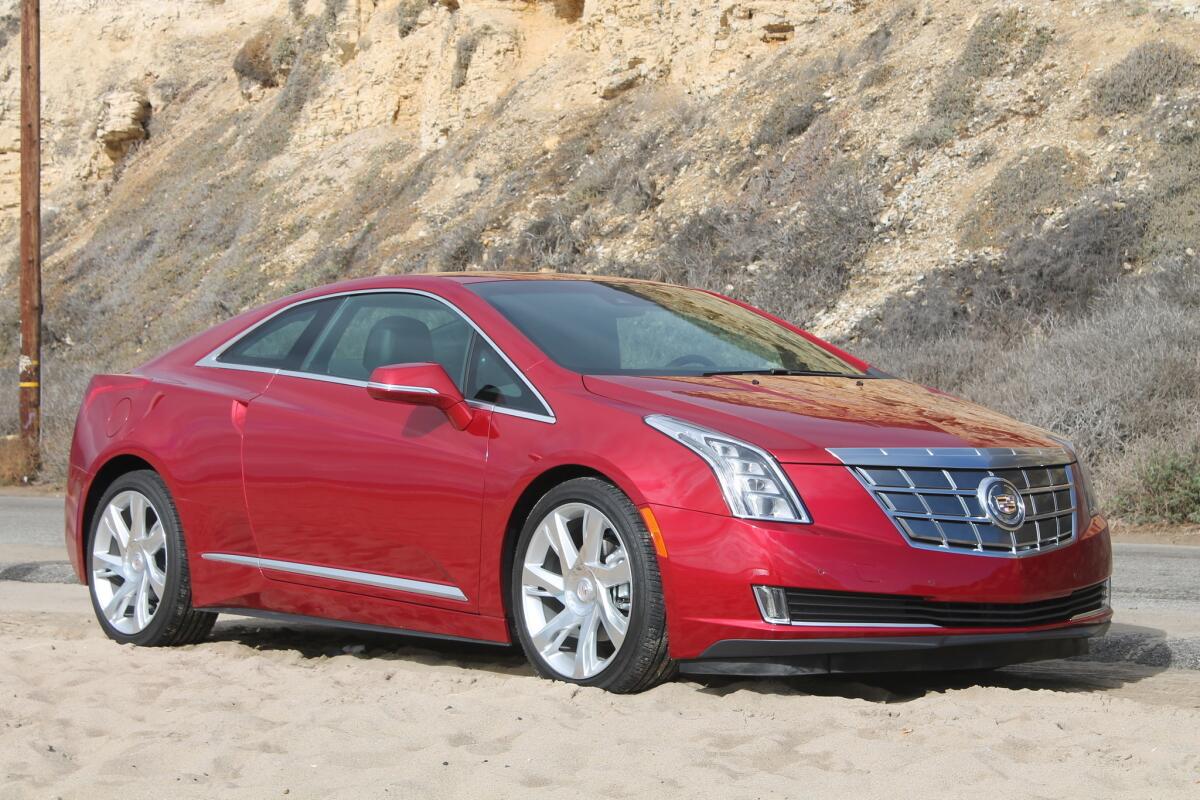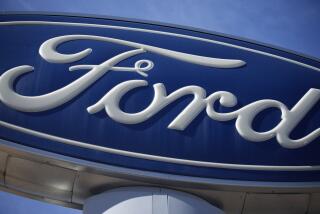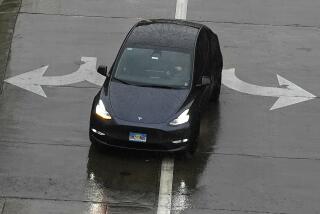Luxury auto brands give eco-friendly a spin

With eco-friendly cars taking center stage at the 2013 L.A. Auto Show, it was no surprise luxury carmakers wanted to tout their stuff too.
And not just far-off concepts that drivers will need to wait years for, either. BMW, Mercedes-Benz and Cadillac each brought production-ready fully electric or plug-in hybrid models.
FOR THE RECORD:
Electric vehicles: In the Nov. 23 Business section, an article about new electric cars said the BMW i3 is front-wheel-drive. The BMW i3 is a rear-wheel-drive car. —
It’s not hard to see why they chose to do this at the Los Angeles show. In 2012, California accounted for 40% of new electric vehicle sales in the U.S., according to IHS Automotive, based on Polk new vehicle registrations.
Although electric cars still make up a tiny fraction of the overall market, Oliver Hazimeh, a consultant at PriceWaterhouseCoopers, says that EV and plug-in hybrid ownership is catching on at a faster rate than hybrids did when they were introduced in 2000. Their market share will more than quadruple by 2020, to around 5% of vehicle sales in the U.S., Hazimeh said.
With this in mind, The Times hopped into the BMW i3, Mercedes-Benz B-Class and Cadillac ELR for brief drives. Each will cruise into dealerships within the next 14 months. Here’s what we thought.
BMW i3
Which element of BMW’s groundbreaking i3 hatchback is more of a departure for the company?
Is it that this is a small city car made by a company that has carefully crafted a reputation for building the “ultimate driving machine”? Or that the i3 is all electric and uses advanced (and expensive) carbon fiber construction to keep weight low and efficiency high?
The i3 starts at $42,275 before any state or federal incentives and goes on sale in spring 2014. It’s the first vehicle from BMW’s new i sub-brand, which has poured piles of money into lightweight carbon fiber technology as well as fully electric and plug-in hybrid drivetrains. The second model, the $137,000 i8 plug-in sports car, will come out later in 2014.
The i3 is a small, upright hatchback with tidy proportions and a futuristic body design that makes it look as if it rolled right off the concept stage at an auto show. Our morning with the car garnered plenty of attention in and around L.A. The i3 sends out the same conspicuous non-consumption vibe that has helped the Toyota Prius become California’s most popular vehicle.
Inside, the design ethos continues, with a clean, open dashboard that evokes a modernist home. The car seats four people and is deceptively roomy for tall passengers in the back seats. There are two normal front doors and two smaller, rear-hinged doors for easy access.
By using the carbon fiber construction for the i3’s passenger shell, curb weight is kept around 2,700 pounds. Pair this with the electric motor’s 170 horsepower and 184 pound-feet of torque and you have a quick little city gadabout that will do zero to 60 mph in about 7.2 seconds. Range is about 80 to 100 miles, BMW said. The car has the turning radius of a tricycle, aiding in mid-street route changes. Yet ultra-small tires and a bit of body roll mean drivers will need to watch their speed if they leave the urban confines for some canyon carving.
The i3 sets BMW’s new brand off in the right direction. It’s a thoughtfully conceived product that could attract a loyal following.
Mercedes-Benz B-Class
When it comes to building EVs, it helps to have friends in high places, like Tesla.
Mercedes-Benz bought a 4.3% stake in Tesla Motors in 2009, and in summer 2014, the fruits of this relationship will show up in the form of the B-Class Electric Drive.
The fully electric, four-door hatchback is built on the popular compact B-Class platform that Mercedes has sold in foreign markets since 2011. For the U.S., the car is offered in an electric-only form.
The battery and electric motor in this Mercedes were developed by Tesla, but don’t think you’re getting a Model S for the $40,000 price at which the B-Class is estimated to start. The propulsion system and battery on the Mercedes are smaller and less powerful than those in Tesla’s car. There’s also no quick-charging system. But it does have a smooth, quiet drivetrain with 174 horsepower and 251 pound-feet of torque. The range on the B-Class EV is a little more than 100 miles, Mercedes said.
Without the lightweight construction of the BMW i3 (and without investing the large sums of cash into such a program), the Mercedes weighs about 1,000 pounds more than its competitor. Thus, its 7.9-second zero-to-62 mph time is about 0.7 of a second slower than the i3’s.
Yet the weight difference gives the Mercedes a more planted, stable feel on the road. Rather than driving like the quick featherweight that is the i3, the B-Class feels like a regular hatchback that just happens not to have a gasoline engine. This was intentional, Mercedes said, as the goal was to make the car look and act as normal as possible.
The interior and exterior give little indication there’s no gas engine under the hood. The outside is a handsome, sleek design at home in any urban setting. Inside, five people can ride comfortably in appreciably straightforward luxury.
This means the handsome hatchback flies below the radar in a way the i3 can’t. Whether this is a good thing depends on what buyers are looking for.
There are plenty of instances in recent automotive history where anonymity has hurt the popularity of a hybrid or EV. People spending a healthy sum on a car whose main focus is efficiency also want others to know about it. Those buyers will like the modernism that is the BMW i3. Those looking for simple luxury that just happens to run on electrons — Tesla’s, no less — will enjoy the Mercedes B-Class Electric Drive.
Cadillac ELR
It’s General Motors’ $76,000 question: Can GM take one of the most substantial and innovative products in its history — the Chevy Volt — and repackage it into a luxury coupe worthy of comparison with the best of German brands?
When the all-new Cadillac ELR goes on sale in early 2014, the two-door plug-in hybrid will start at $76,000 and top out around $80,000. Although its drivetrain is basically that of the more humble Chevy Volt, the ELR will target buyers looking for style and luxury first and a planet-saving ethos second.
Like the Volt, in most driving situations the ELR’s electric motor initially draws its power (207 horsepower and 295 pound-feet of torque) from the 435-pound lithium-ion battery. Its pure-electric range is around 35 miles, GM says, though it can go 345 total miles with the gasoline engine recharging the battery. These electric-only miles tick by with all the serenity and luxury you’d hope a coupe with this striking future-forward design could muster.
Once the battery’s power is drained, the front-wheel-drive ELR uses a 1.4-liter inline four-cylinder engine as an on-board generator. Unfortunately, the engine kicks in with all the subtlety and refinement of a rusty chain saw. The disconnect between the high-dollar surroundings and the rough noise is jarring.
The racket quiets down after a few minutes, but the engine can still be heard droning as it works to recharge the battery, especially when you push it hard on onramps or while passing. That it isn’t quieter or more subtle is troubling in a $76,000 luxury coupe.
That price tag could be the determining factor in the ELR’s success. Cadillac’s expectations for the car are modest — 3,000 to 5,000 sales a year. Yet the math just doesn’t add up for this Cadillac. Strip out the drivetrain and replace it with a small turbocharged four-cylinder gas engine with similar power to what’s in there now, and you’re looking at a nice coupe that could sell for $50,000.
Which means the answer to this $76,000 question is no.
david.undercoffler@latimes.com
More to Read
Inside the business of entertainment
The Wide Shot brings you news, analysis and insights on everything from streaming wars to production — and what it all means for the future.
You may occasionally receive promotional content from the Los Angeles Times.











